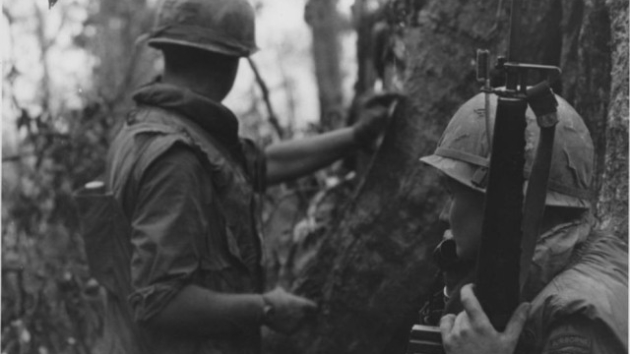In 1968, the Tet Offensive began in South Vietnam
I was a young 2nd Lieutenant with A Company, 2nd Battalion 501st Airborne Infantry, 2nd Brigade, 101st Airborne Division in Vietnam when the Tet Offensive began. We fought for weeks to destroy the enemy and my company secured the Western wall of Hue City.
According to a US Army Center for History report on Tet of 1968, “As the 1st and 3d Brigades moved into the corridor along Highway 1 between Quang Tri City and Hue, the 2d Brigade, 101st Airborne Division, commanded by Col. John H. Cushman, redeployed from Cu Chi in III Corps, northwest of Saigon, to Landing Zone El Paso. The brigade completed its move via C−130 transport aircraft through the Phu Bai and Quang Tri City airfields between 23 and 29 January. After establishing a headquarters at Landing Zone El Paso, which continued to serve as the 1st Cavalry Division’s rear logistical area, Colonel Cushman sent the 1st Battalion, 502d Infantry, to Landing Zone Betty on 27 January to beef up Colonel Rattan’s 1st Brigade. Rattan used the paratroopers to protect his brigade headquarters, freeing his cavalry units to commence search-and-destroy missions. Cushman’s two remaining units, the 1st Battalion, 501st Infantry, and the 2d Battalion, 502d Infantry, remained at Landing Zone El Paso for its defense. Once American patrols had time to sweep the surrounding countryside and verify that no enemy units were nearby, Cushman moved the 1st Battalion, 501st Infantry, to Landing Zone Jane on 30 January to assist Colonel Rattan’s 1st Brigade in operations against Base Area 101.”
I vividly remember being in a makeshift bunker on a knoll when all hell broke loose on this very day forty-six years ago on January 30, 1968.
The following narrative is courtesy of Special Forces Gear:
At dawn on the first day of the TET holiday truce, Viet Cong forces–supported by large numbers of North Vietnamese troops–launch the largest and best coordinated offensive of the war, driving into the center of South Vietnam’s seven largest cities and attacking 30 provincial capitals from the Delta to the DMZ.
Among the cities taken during the first four days of the offensive were Hue, Dalat, Kontum, and Quang Tri; in the north, all five provincial capitals were overrun. At the same time, enemy forces shelled numerous Allied airfields and bases. In Saigon, a 19-man Viet Cong suicide squad seized the U.S. Embassy and held it for six hours until an assault force of U.S. paratroopers landed by helicopter on the building’s roof and routed them. Nearly 1,000 Viet Cong were believed to have infiltrated Saigon, and it took a week of intense fighting by an estimated 11,000 U.S. and South Vietnamese troops to dislodge them.

By February 10, the offensive was largely crushed, but with heavy casualties on both sides. The former Imperial capital of Hue took almost a month of savage house-to-house combat to regain. Efforts to assess the offensive’s impact began well before the fighting ended. On February 2, President Johnson announced that the Viet Cong had suffered complete military defeat. General Westmoreland echoed that appraisal four days later in a statement declaring that Allied forces had killed more enemy troops in the previous seven days than the United States had lost in the entire war.
 The scene is Hue, during its darkest moment-the infamous TET offensive. U.S. marines are keeping low because of intense sniper fire from communists units which seized two-thirds of the ancient imperial Capital 2/4/1968. The Marines were pinned down behind this wall near the old citadel and radioed for support. U.S. spokesmen reported that leathernecks hauled down the North Vietnamese flag after seven days of fighting and recaptured the city. (UPI photo)
The scene is Hue, during its darkest moment-the infamous TET offensive. U.S. marines are keeping low because of intense sniper fire from communists units which seized two-thirds of the ancient imperial Capital 2/4/1968. The Marines were pinned down behind this wall near the old citadel and radioed for support. U.S. spokesmen reported that leathernecks hauled down the North Vietnamese flag after seven days of fighting and recaptured the city. (UPI photo)
Militarily, Tet was decidedly an Allied victory, but psychologically and politically, it was a disaster. The offensive was a crushing military defeat for the Viet Cong and the North Vietnamese, but the size and scope of the communist attacks caught the American and South Vietnamese allies by surprise. The early reporting of a smashing communist victory went largely uncorrected in the media and led to a psychological victory for the communists. The heavy U.S. and South Vietnamese casualties incurred during the offensive, coupled with the disillusionment over the earlier overly optimistic reports of progress in the war, accelerated the growing disenchantment with President Johnson’s conduct of the war.
Johnson, frustrated with his inability to reach a solution in Vietnam, announced on March 31, 1968, that he would neither seek nor accept the nomination of his party for re-election.
RELATED ARTICLES: Last Days in Vietnam paints a startling portrait of defeat snatched from the jaws of victory by Congress



Trackbacks & Pingbacks
[…] In 1968, the Tet Offensive began in South Vietnam […]
Comments are closed.